Catholic Customs
 |
 |
 |
 |
 |
 |
 |
All Hallows Eve: Joyful Anticipation
The feast of All Saints was established on November 1 by Pope Gregory IV in 844. In 1484, Pope Sixtus IV elevated the feast to a Holy Day of obligation with a vigil and octave. The feast was known as "All Hallows" in England, hence the name for the eve "All Hallows' Eve," or "Hallowe'en."
All Hallows Eve was traditionally a fasting day, but it was a joyful fasting day: "It shares with Christmas Eve the exceptional honor of being celebrated with mirth and jollity." (Frederick William Hackwood, Christ Lore, p. 252) Thus was Halloween a day to joyfully prepare for two of the greatest feasts of the Church Liturgical Year.
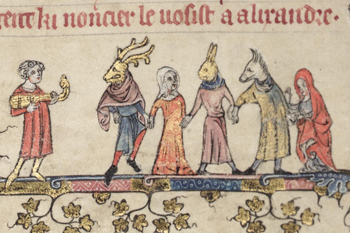 In many countries, the three days of Allhallowtide (All Hallows Eve, All Saints, and All Souls) signaled the decline of Autumn, when the harvest work ended and the preparation for Winter began. In Celtic countries these were the days the animals would be brought home from their pastures.
In many countries, the three days of Allhallowtide (All Hallows Eve, All Saints, and All Souls) signaled the decline of Autumn, when the harvest work ended and the preparation for Winter began. In Celtic countries these were the days the animals would be brought home from their pastures.
This was the time to commemorate the dead, for it was believed that on these nights spirits of the dead roamed the earth. Many peoples believed that during Hallowtide the "veil between the worlds," this world and the next, was "thinner" than normal. These beliefs must have had some grounding in reality, which is why it is especially important to pray and to make outward signs of the faith to quell the demons, who were more active and present at this time of the year.
All Hallows Eve was always a very special day in the eyes of Catholics. In times past, the Church bells would ring for an extended period throughout the night of All Hallows Eve to give fitting praise to the Saints and to remind the faithful to pray for the Holy Souls.
The spirit of this night is expressed well by Dom Guéranger: "The bells ring out joyously as on the brightest days. They announce the great solemnity of the closing cycle: The feast which shows us time stamped with the impress of eternity, and God taking possession of the declining year and gathering in its harvest. At the sound of their triumphant and harmonious peals, the Church, prostrate and fasting since morning, raises her brow to the light." (The Liturgical Year, vol. XV, p. 59).
Bonfires and Lanterns
For the peoples of the British Isles, Halloween night was a night for feasting over a bonfire with nuts, apples and cider. In northern England, Halloween was called "Nutcracker Night" and often chestnuts were roasted over the fire.
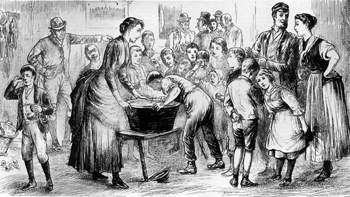 Apples were an intrinsic part of the Halloween celebration, which is fitting since they represent the tree of Paradise, and this is the time of year to pray that the dead may go to Paradise. Many traditional games were played on this night, including "Bobbing for Apples" and "Snap Apple" (using one's mouth to catch an apple hanging on a string).
Apples were an intrinsic part of the Halloween celebration, which is fitting since they represent the tree of Paradise, and this is the time of year to pray that the dead may go to Paradise. Many traditional games were played on this night, including "Bobbing for Apples" and "Snap Apple" (using one's mouth to catch an apple hanging on a string).
The traditional Irish food for this night was some sort of fasting potato dish, such as Boxty dumplings, Boxty bread, Boxty pancakes, Colcannon or Champs served with butter or buttermilk and filled with trinkets that told the finder's future (a ring predicted a wedding, a dried pea prosperity, etc.). Irish Barmbrack (a bread filled with dried fruits) and Scottish Dirge Cake were other traditional foods into which trinkets were placed. The English baked potatoes in the ashes and served them with cream and butter.
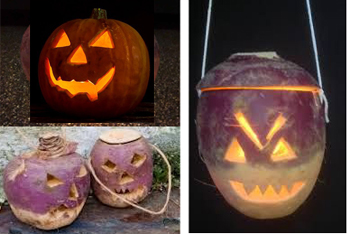 Bonfires, traditionally lit on the eves of All Saints and All Souls, were symbolic of the immortality of the soul. They also served to call to mind the flames of Purgatory. The bonfires were thought to be efficacious, as an outward and visible sign at least, for lighting the way of souls from Purgatory to Heaven.
Bonfires, traditionally lit on the eves of All Saints and All Souls, were symbolic of the immortality of the soul. They also served to call to mind the flames of Purgatory. The bonfires were thought to be efficacious, as an outward and visible sign at least, for lighting the way of souls from Purgatory to Heaven.
In Mexico, also, the two eves were celebrated with the lighting of bonfires and the hanging of lanterns in trees as lights to guide the souls to their home.
Carved pumpkin lanterns were found in many regions of Central Europe including Austria, southern Germany, Switzerland and the Slavic countries. In Ireland, Scotland and England, turnips, potatoes or beets were carved and made into lanterns to hang on fence posts or be carried. These lanterns also served as "lights for the Holy Souls" as well as lights to drive away any evil.
Souling
Souling is a custom that goes back to the Medieval times – a sermon from the 1300s makes mention of it. Many regions had "black clad men who went from house to house collecting money and gifts to pay for Masses for the dead. A man draped in white and wearing a horse's head accompanied them." (Elizabeth Luard, European Festival Food, p. 393).
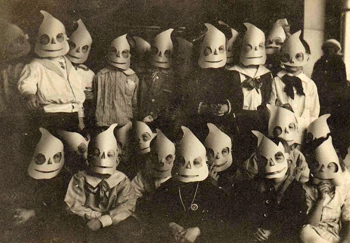
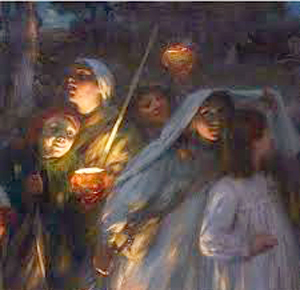 On both Eves, children, old women and poor men of the British Isles would go from house to house begging for ale, cakes, apples or coins; in return the beggars would pray for the souls of the donor's departed loved ones. British housewives would lay out soul cakes for the "soulers" as they passed their homes. Many regions made this custom theatrical with special rhymes, songs and even plays.
On both Eves, children, old women and poor men of the British Isles would go from house to house begging for ale, cakes, apples or coins; in return the beggars would pray for the souls of the donor's departed loved ones. British housewives would lay out soul cakes for the "soulers" as they passed their homes. Many regions made this custom theatrical with special rhymes, songs and even plays.
Here is one of the many Souling rhymes:
Soul! Soul! for a soul cake!
I pray, good missis, a soul cake!
An apple, a pear, a plum or a cherry,
Any good thing to make us merry.
One for Peter, one for Paul,
Three for Him who made us all.
Up with the kettle and down with the pan.
Give us good alms and we'll be gone.
In Cheshire, soul-caking plays were performed during the visits to neighbor's houses. The most popular portrayed St. George and the Black Prince, who was slayed by St. George at the end of the play. Children carrying turnip lanterns would dress up and go through the village asking for sweets in some places of Scotland.
In some regions of Ireland, it was the men who went from door to door, collecting food to prepare the morrow's feast. As the men collected victuals, the women baked griddle cakes and made candles. The candles were sent to neighboring houses to be lit on All Saints Day; in return the receivers would light the candle and pray for the departed souls of the giver's family.
In lower Austria on All Saints' Day, the children had a custom similar to souling known as "Heiligenstritzellaufen." At every house the children gave a speech, graciously asking for the traditional "All Saints' Day Wreath" (a round cake with layers of pastry). In other Austrian regions, beggars and poor children sang hymns and recited prayers for the Holy Souls as they walked from door to door asking for "soul bread."
In the Philippines, young men, representing souls released from Purgatory on their way to Heaven, stopped by every house on All Soul's Eve singing a song asking for sweets:
If you will give us friendly alms, please do not make us wait;
We want to enter Heaven's door, before it is too late. (The Holyday Book, p. 129)
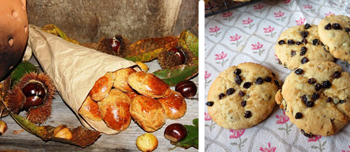 In Portugal, children walked the streets on All Saints Day stopping at each door to sing a song asking for Pão-por-Deus (bread for God). They were given cakes, nuts, pomegranates and bread.
In Portugal, children walked the streets on All Saints Day stopping at each door to sing a song asking for Pão-por-Deus (bread for God). They were given cakes, nuts, pomegranates and bread.
The Italians too had their "souling" customs. In Emilia Romagna, the poor went from house to house asking for "carità di murt" (the charity of the dead) and receiving food. In Abruzzo, pumpkins were carved and decorated, and children asked their neighbors for gifts of seasonal fruit, dried fruit and sweets "for the souls of the dead."
A similar custom was observed in Sardinia where, after visiting the cemetery and attending Mass on All Saints Day, the children chimed a little rhyme about death ("Morti, morti…") to receive sweets, cakes and nuts.
Halloween customs today
Halloween has been so distorted and perverted in our days. Recalling these charming and innocent customs can help us understand the true spirit of the feast. Rather than showing an affinity for demons and witches, Halloween should be a night to remember the existence of evil and to pray, using holy water, blessed candles and salt as exterior signs for protection against the evil.
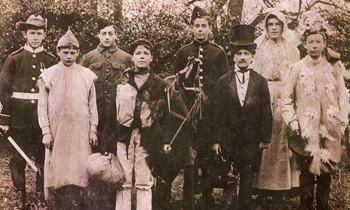 The customs of the past give Catholic families of the present a fitting example of how to honor the Saints, remember the Holy Souls and drive away the demons: lighting bonfires, making lanterns of carved pumpkins or turnips, and ringing bells (preferably church bells, but unfortunately these often no longer ring).
The customs of the past give Catholic families of the present a fitting example of how to honor the Saints, remember the Holy Souls and drive away the demons: lighting bonfires, making lanterns of carved pumpkins or turnips, and ringing bells (preferably church bells, but unfortunately these often no longer ring).
Sprinkling Holy Water on the fire and candles would be a good way to serve the two purposes of the feast: to commemorate the Saints and Holy Souls and to keep away the demons.
The ancient custom of "souling" can also be restored as a charming way to show charity to the Holy Souls and our neighbor. Many peoples and regions had their souling customs; one need only find what suits his spirit and ancestry.
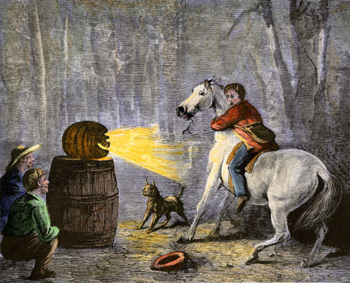 If men would lead the souling, the proper spirit will return, for these traditions were not just matters for women and children. They were rooted in family traditions that allowed the members – young and old, rich and poor – to enter the Liturgical Year and live it as a reality with all the sacrality, charm and spirit summoned by the particular feast.
If men would lead the souling, the proper spirit will return, for these traditions were not just matters for women and children. They were rooted in family traditions that allowed the members – young and old, rich and poor – to enter the Liturgical Year and live it as a reality with all the sacrality, charm and spirit summoned by the particular feast.
Dressing up in costumes, singing souling songs, and performing a play while souling (see here the traditional script for the Cheshire play), and all the while praying prayers for the dead can bring back the traditional spirit and import of All Hallows Eve.
Of course, the womenfolk can bake soul cakes for the "soulers" and prepare apples, nuts, cider and a potato dish for a fitting feast and joyful end to the evening, leaving all to spend the night in anticipation of the great Feast of All Saints.
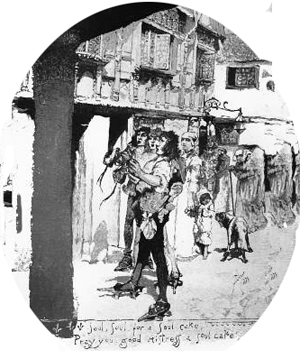

Posted October 30, 2020
All Hallows Eve was traditionally a fasting day, but it was a joyful fasting day: "It shares with Christmas Eve the exceptional honor of being celebrated with mirth and jollity." (Frederick William Hackwood, Christ Lore, p. 252) Thus was Halloween a day to joyfully prepare for two of the greatest feasts of the Church Liturgical Year.

A whimsical illustration of medieval ‘mummers' or soulers
This was the time to commemorate the dead, for it was believed that on these nights spirits of the dead roamed the earth. Many peoples believed that during Hallowtide the "veil between the worlds," this world and the next, was "thinner" than normal. These beliefs must have had some grounding in reality, which is why it is especially important to pray and to make outward signs of the faith to quell the demons, who were more active and present at this time of the year.
All Hallows Eve was always a very special day in the eyes of Catholics. In times past, the Church bells would ring for an extended period throughout the night of All Hallows Eve to give fitting praise to the Saints and to remind the faithful to pray for the Holy Souls.
The spirit of this night is expressed well by Dom Guéranger: "The bells ring out joyously as on the brightest days. They announce the great solemnity of the closing cycle: The feast which shows us time stamped with the impress of eternity, and God taking possession of the declining year and gathering in its harvest. At the sound of their triumphant and harmonious peals, the Church, prostrate and fasting since morning, raises her brow to the light." (The Liturgical Year, vol. XV, p. 59).
Bonfires and Lanterns
For the peoples of the British Isles, Halloween night was a night for feasting over a bonfire with nuts, apples and cider. In northern England, Halloween was called "Nutcracker Night" and often chestnuts were roasted over the fire.

Bobbing for apples
The traditional Irish food for this night was some sort of fasting potato dish, such as Boxty dumplings, Boxty bread, Boxty pancakes, Colcannon or Champs served with butter or buttermilk and filled with trinkets that told the finder's future (a ring predicted a wedding, a dried pea prosperity, etc.). Irish Barmbrack (a bread filled with dried fruits) and Scottish Dirge Cake were other traditional foods into which trinkets were placed. The English baked potatoes in the ashes and served them with cream and butter.

Traditional turnip and pumpkin laterns with fire to keep away the evil spirits
In Mexico, also, the two eves were celebrated with the lighting of bonfires and the hanging of lanterns in trees as lights to guide the souls to their home.
Carved pumpkin lanterns were found in many regions of Central Europe including Austria, southern Germany, Switzerland and the Slavic countries. In Ireland, Scotland and England, turnips, potatoes or beets were carved and made into lanterns to hang on fence posts or be carried. These lanterns also served as "lights for the Holy Souls" as well as lights to drive away any evil.
Souling
Souling is a custom that goes back to the Medieval times – a sermon from the 1300s makes mention of it. Many regions had "black clad men who went from house to house collecting money and gifts to pay for Masses for the dead. A man draped in white and wearing a horse's head accompanied them." (Elizabeth Luard, European Festival Food, p. 393).

Boys in Sardinia ready to go souling; below, British Isle children with their pumpkin laterns

Here is one of the many Souling rhymes:
Soul! Soul! for a soul cake!
I pray, good missis, a soul cake!
An apple, a pear, a plum or a cherry,
Any good thing to make us merry.
One for Peter, one for Paul,
Three for Him who made us all.
Up with the kettle and down with the pan.
Give us good alms and we'll be gone.
In Cheshire, soul-caking plays were performed during the visits to neighbor's houses. The most popular portrayed St. George and the Black Prince, who was slayed by St. George at the end of the play. Children carrying turnip lanterns would dress up and go through the village asking for sweets in some places of Scotland.
In some regions of Ireland, it was the men who went from door to door, collecting food to prepare the morrow's feast. As the men collected victuals, the women baked griddle cakes and made candles. The candles were sent to neighboring houses to be lit on All Saints Day; in return the receivers would light the candle and pray for the departed souls of the giver's family.
In lower Austria on All Saints' Day, the children had a custom similar to souling known as "Heiligenstritzellaufen." At every house the children gave a speech, graciously asking for the traditional "All Saints' Day Wreath" (a round cake with layers of pastry). In other Austrian regions, beggars and poor children sang hymns and recited prayers for the Holy Souls as they walked from door to door asking for "soul bread."
In the Philippines, young men, representing souls released from Purgatory on their way to Heaven, stopped by every house on All Soul's Eve singing a song asking for sweets:
If you will give us friendly alms, please do not make us wait;
We want to enter Heaven's door, before it is too late. (The Holyday Book, p. 129)

Pão-por-Deus (bread for God) and British soul cakes
The Italians too had their "souling" customs. In Emilia Romagna, the poor went from house to house asking for "carità di murt" (the charity of the dead) and receiving food. In Abruzzo, pumpkins were carved and decorated, and children asked their neighbors for gifts of seasonal fruit, dried fruit and sweets "for the souls of the dead."
A similar custom was observed in Sardinia where, after visiting the cemetery and attending Mass on All Saints Day, the children chimed a little rhyme about death ("Morti, morti…") to receive sweets, cakes and nuts.
Halloween customs today
Halloween has been so distorted and perverted in our days. Recalling these charming and innocent customs can help us understand the true spirit of the feast. Rather than showing an affinity for demons and witches, Halloween should be a night to remember the existence of evil and to pray, using holy water, blessed candles and salt as exterior signs for protection against the evil.

English boys in costume for the Cheshire play in 1920
Sprinkling Holy Water on the fire and candles would be a good way to serve the two purposes of the feast: to commemorate the Saints and Holy Souls and to keep away the demons.
The ancient custom of "souling" can also be restored as a charming way to show charity to the Holy Souls and our neighbor. Many peoples and regions had their souling customs; one need only find what suits his spirit and ancestry.

Innocent Halloween fun with a carved pumpkin
Dressing up in costumes, singing souling songs, and performing a play while souling (see here the traditional script for the Cheshire play), and all the while praying prayers for the dead can bring back the traditional spirit and import of All Hallows Eve.
Of course, the womenfolk can bake soul cakes for the "soulers" and prepare apples, nuts, cider and a potato dish for a fitting feast and joyful end to the evening, leaving all to spend the night in anticipation of the great Feast of All Saints.

Medieval soulers in merry England

Posted October 30, 2020
______________________
______________________
 |
 |
 |
 |
 |
 |


